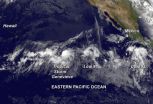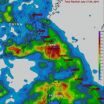(Press-News.org) The seventh tropical depression of the Eastern Pacific Ocean formed and quickly ramped up to a tropical storm named "Genevieve." NOAA's GOES-West satellite captured an infrared image of the newborn storm being trailed by two other areas of developing low pressure to its east.
The National Hurricane Center (NHC) noted that Tropical Storm Genevieve was born on July 25 at 5 a.m. EDT. At that time, Genevieve had maximum sustained winds near 40 mph (65 kph). It was located near 12.2 north latitude and 134.4 west longitude, about 1,490 miles (2,400 km) east-southeast of South Point, Hawaii.
NOAA's GOES-West satellite captured an infrared picture of Genevieve on July 25 at 8 a.m. EDT. The bulk of the storm's clouds appeared to be pushed east of the center, indicating that westerly wind shear was affecting the storm. The GOES image also showed that Genevieve was being "followed" by two other developing areas of low pressure to the east of the storm.
By 11 a.m. EDT (1500 UTC), Genevieve's winds increased to 45 mph (75 kph). The center of Tropical Storm Genevieve was located near latitude 12.3 north and longitude 135.5 west, moving 70 miles closer to South Point, Hawaii but still over 1,400 miles away. Genevieve was moving toward the west near 10 mph (17 kph) and NHC expects her to continue moving in a westerly direction over the next day or two. The estimated minimum central pressure is 1004 millibars.
NHC Forecaster Avila indicated that Genevieve's low-level center continues to be located to the west of the convection. The NHC doesn't expect Genevieve to strengthen because upper-level westerly winds are expected to move closer to the tropical storm and increase wind shear. Increased wind shear weakens tropical cyclones.
Trailing behind Genevieve to the storm's east are two other developing low pressure areas. Area #1 is located a little more than a thousand miles southwest of the southern tip of the Baja California, Mexico peninsula and is producing disorganized shower activity. The National Hurricane Center noted that there is some potential for development during the next day or two before the environment becomes unfavorable. Right now the low has a medium chance for development over the next two days as it moves to the west or west-northwest
East-southeast of Area #1 is the second developing low pressure area and south of Mexico's southern coast. That low, however is large and disorganized. The showers and thunderstorms in that area are associated with a tropical wave. Area #2 has a low chance for development over the next two days, according to NHC, but its chances are expected to improve five days out.
INFORMATION:
Rob Gutro
NASA's Goddard Space Flight Center
Tropical Storm Genevieve forms in Eastern Pacific
2014-07-25
ELSE PRESS RELEASES FROM THIS DATE:
Climate change increases risk of crop slowdown in next 20 years
2014-07-25
BOULDER -- The world faces a small but substantially increased risk over the next two decades of a major slowdown in the growth of global crop yields because of climate change, new research finds.
The authors, from Stanford University and the National Center for Atmospheric Research (NCAR), say the odds of a major production slowdown of wheat and corn even with a warming climate are not very high. But the risk is about 20 times more significant than it would be without global warming, and it may require planning by organizations that are affected by international food ...
Whitehead Institute researchers create 'naïve' pluripotent human embryonic stem cells
2014-07-25
CAMBRIDGE, Mass. (July 24, 2014) – For years, researchers and patients have hoped that embryonic stem cells (ESCs)—capable of forming nearly any cell type in the body—could provide insight into numerous diseases perhaps even be used to treat them. Yet progress has been hampered by the inability to transfer research and tools from mouse ESC studies to their human counterparts, in part because human ESCs are "primed" and slightly less plastic than the mouse cells.
Now Thorold Theunissen, Benjamin Powell, and Haoyi Wang, who are scientists in the lab of Whitehead Institute ...
Scientists test nanoparticle 'alarm clock' to awaken immune systems put to sleep by cancer
2014-07-25
(Lebanon, NH, 7/25/14) — Researchers at Dartmouth-Hitchcock Norris Cotton Cancer Center are exploring ways to wake up the immune system so it recognizes and attacks invading cancer cells. Tumors protect themselves by tricking the immune system into accepting everything as normal, even while cancer cells are dividing and spreading.
One pioneering approach, discussed in a review article published this week in WIREs Nanomedicine and Nanobiotechnology, uses nanoparticles to jumpstart the body's ability to fight tumors. Nanoparticles are too small to imagine. One billion ...
Clearing cells to prevent cervical cancer
2014-07-25
Boston, MA – A study published online in the International Journal of Cancer earlier this month describes a novel approach to preventing cervical cancer based on findings showing successful reduction in the risk of cervical cancer after removal of a discrete population of cells in the cervix.
The findings come from a study that looked at squamocolumnar junction cells, or SCJ cells. These cells reside in the cervical canal and have been implicated as the origins of cervical cancer. A research team co-led by Christopher Crum, MD, director, Brigham and Women's Hospital ...
Manipulating key protein in the brain holds potential against obesity and diabetes
2014-07-25
DALLAS -- A protein that controls when genes are switched on or off plays a key role in specific areas of the brain to regulate metabolism, UT Southwestern Medical Center researchers have found.
The research potentially could lead to new therapies to treat obesity and diabetes, since the transcription factor involved – spliced X-box binding protein 1 (Xbp1s) – appears to influence the body's sensitivity to insulin and leptin signaling. Insulin and leptin are hormones central to the body's regulation of food intake and sugar disposal, and obesity and diabetes are conditions ...
Why do men prefer nice women?: Responsiveness and desire
2014-07-25
People's emotional reactions and desires in initial romantic encounters determine the fate of a potential relationship. Responsiveness may be one of those initial "sparks" necessary to fuel sexual desire and land a second date. However, it may not be a desirable trait for both men and women on a first date. Does responsiveness increase sexual desire in the other person? Do men perceive responsive women as more attractive, and does the same hold true for women's perceptions of men? A study published in Personality and Social Psychology Bulletin seeks to answer those questions. ...
ACR statement on cancer study regarding patient anxiety from CT lung cancer screening
2014-07-25
Anxiety regarding inconclusive cancer screening test results among some patients is real and is only natural. However, as evidenced by Gareen et al, published July 25 in Cancer, the incidence and effects of anxiety associated with false positive or other results of computed tomography (CT) lung cancer screening exams are far less than claimed by some in the medical community.
"Unsubstantiated claims of systemic and harmful patient anxiety should now be put to rest and not continue to delay implementation of CT lung cancer screening programs or Medicare coverage for these ...
Vanderbilt study examines bacteria's ability to fight obesity
2014-07-25
A probiotic that prevents obesity could be on the horizon. Bacteria that produce a therapeutic compound in the gut inhibit weight gain, insulin resistance and other adverse effects of a high-fat diet in mice, Vanderbilt University investigators have discovered.
"Of course it's hard to speculate from mouse to human," said senior investigator Sean Davies, Ph.D., assistant professor of Pharmacology. "But essentially, we've prevented most of the negative consequences of obesity in mice, even though they're eating a high-fat diet."
Regulatory issues must be addressed before ...
NSU researcher part of team studying ways to better predict intensity of hurricanes
2014-07-25
FORT LAUDERDALE-DAVIE, Fla. – They are something we take very seriously in Florida – hurricanes. The names roll off the tongue like a list of villains – Andrew, Charlie, Frances and Wilma.
In the past 25 years or so, experts have gradually been improving prediction of the course a storm may take. This is thanks to tremendous advancements in computer and satellite technology. While we still have the "cone of uncertainty" we've become familiar with watching television weather reports, today's models are more accurate than they used to be.
The one area, however, where ...
NASA maps Typhoon Matmo's Taiwan deluge
2014-07-25
When Typhoon Matmo crossed over the island nation of Taiwan it left tremendous amounts of rainfall in its wake. NASA used data from the TRMM satellite to calculate just how much rain fell over the nation.
The Tropical Rainfall Measuring Mission or TRMM satellite orbits the Earth and provides coverage over the tropics. TRMM is a satellite that is managed by both NASA and the Japan Aerospace Exploration Agency (JAXA) that acts as a "flying rain gauge in space," that can estimate how fast rain is falling within storms on Earth and how much rain has fallen.
On July 22, ...


